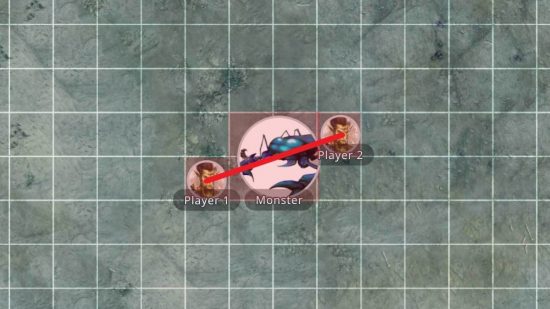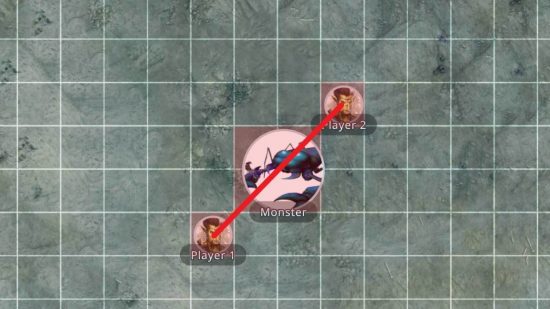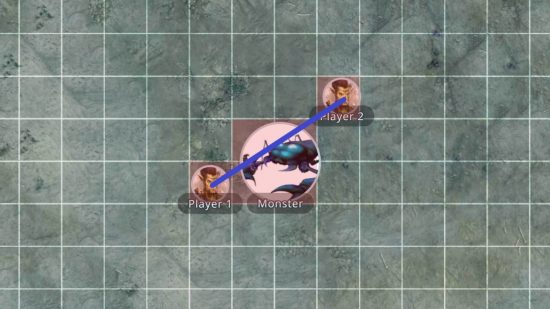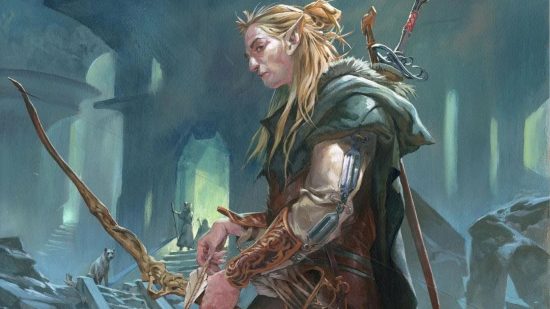The flanking 5e rules are a way for combatants to gain advantage on attacks through positioning. DnD flanking is an optional rule that has just as many detractors as followers. So here we’ll not only fill you in on how it works, we’ll also discuss the arguments for and against including flanking in your DnD campaign.
DnD flanking rules
Flanking is all about getting up close, so you’re more likely to be able to take advantage of it if both you and a party member are playing a martial DnD class like the Fighter 5e, Paladin 5e, or Barbarian 5e.
The short version of the DnD flanking rules is that a creature is flanking if it’s adjacent to an enemy and one of its allies is also adjacent, and on an opposite side or corner of the enemy. While flanking an enemy, you have advantage on melee attack rolls you make against it.
You’ll most commonly use the flanking ability when playing with a tactical grid. In these cases, the Dungeon Master’s Guide provides a pretty simple way to double check if you’re flanking an enemy: “Trace an imaginary line between the centers of the creatures’ spaces. If the line passes through opposite sides or corners of the enemy’s space, the enemy is flanked”.
That means in the diagram below, the monster is flanked, as the line passes through opposite sides of the enemy’s space.
And in this diagram, the line passes through opposite corners of the enemy’s space, so once again this is valid flanking.
But how about this example? Here’s where the official wording is a bit unclear. While intuitively, this looks a lot like flanking, the rules state the line must pass through opposite sides or opposite corners.
Therefore the example above, where the line goes through one side and one corner, probably isn’t flanking (but again, the wording is unclear, so you’ll probably have to come to an agreement on this during or before play).
Other edge cases: a creature can’t flank or contribute to flanking while it has the incapacitated 5e condition, or while it can’t see the enemy it’s adjacent to. A creature of DnD size large or greater (i.e. one that takes up multiple spaces on a grid) is flanking provided one of its squares would count as flanking.
And if you’re using hexagons, simply count around the enemy the number of squares between you and your ally. Against a medium (one hex) creature, there must be two clear spaces between the allies. Against a large creature, it’s four. Then it’s five for huge, and six or more for gargantuan.
But is Flanking 5e a way to add a bit more depth and strategy to DnD’s combat system by encouraging clever positioning, or is it a sop to realism that actively hampers the game’s ruleset?
Should you use flanking?
While the flanking rules feel intuitive and realistic, some players and DMs despise them.
The issue is that, compared to 4th edition, flanking in 5e is easier to achieve and provides a more significant bonus. Creatures only get one attack of opportunity, individual attacks are less damaging so being struck by an opportunity attack matters less, and you get the reroll effect of advantage, rather than just a bonus to hit.
Having such an easily accessible source of advantage also makes a lot of character options, which seem to have been designed under the assumption that flanking is not in the game, feel pointless.
DnD 5e spells that serve to provide advantage, like Faerie Fire, become uneccessary, as do class features like the Barbarian’s Reckless Attack. Certain character options, like the Samurai 5e, a popular DnD Fighter subclass, are also less appealing.
Advantage actually risks taking variety out of combat: when simply moving lets you gain the powerful benefit of advantage, there’s less reason to consider tactical options beyond just getting into position and swinging your sword.
A counterargument is that if combats are set up effectively using terrain features and sizable groups of intelligent enemies, it can be more difficult for players to effectively flank. Trying to flank may isolate the flanking ally, or leave a squishy 5e Wizard open to getting swamped. And when the adventuring party is outnumbered, it’s more likely the monsters will be the ones flanking.
Furthermore, there are some balance-related benefits to using flanking. It balances out the overwhelming benefit currently enjoyed by ranged 5e weapons over melee weapons (mainly safety).
A common homebrew compromise, which allows the flanking enjoyers to still make use of the tactic, while dealing with many of its detractors’ complaints, is to rule that flanking provides a flat +2 or +1 bonus to hit, rather than the wildly powerful effect of advantage.
Can you use flanking with theater of the mind?
The official DnD rules suggest you use flanking when you’re playing with DnD miniatures and battlemaps, but it is technically possible to play when keeping combat abstract and using ‘theater of the mind’. You’ll still use AoE spells, attacks of opportunity, and other rules that depend upon positioning when playing without a battlemap, so why not flanking?
However, if you are using theater of the mind, you may want to think carefully about including this optional rule.
Using flanking can slow the game down or cause it to devolve into squabbles about the relative positioning of different combatants. The flanking rules give much higher stakes to character’s positions in battle, and to avoid confusion, the DM is going to have to be very careful when describing where everyone is and how they are moving.
Each time a rule which depends upon positioning is added to the game, it creates another factor for the players and DM to keep track of. Eventually, the mental load becomes too much.
At a certain point, we suspect, it’s going to be easier to start using DnD maps to keep track, or to just drop the flanking rules altogether.
For more RPG content, check out the complicated grapple 5e rules, or take a look at our extensive guide to DnD races or DnD subclasses.







